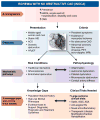Ischemia and No Obstructive Coronary Artery Disease (INOCA): Developing Evidence-Based Therapies and Research Agenda for the Next Decade
- PMID: 28289007
- PMCID: PMC5385930
- DOI: 10.1161/CIRCULATIONAHA.116.024534
Ischemia and No Obstructive Coronary Artery Disease (INOCA): Developing Evidence-Based Therapies and Research Agenda for the Next Decade
Abstract
The Cardiovascular Disease in Women Committee of the American College of Cardiology, in conjunction with interested parties (from the National Heart, Lung, and Blood Institute, American Heart Association, and European Society of Cardiology), convened a working group to develop a consensus on the syndrome of myocardial ischemia with no obstructive coronary arteries. In general, these patients have elevated risk for a cardiovascular event (including acute coronary syndrome, heart failure hospitalization, stroke, and repeat cardiovascular procedures) compared with reference subjects and appear to be at higher risk for development of heart failure with preserved ejection fraction. A subgroup of these patients also has coronary microvascular dysfunction and evidence of inflammation. This document provides a summary of findings and recommendations for the development of an integrated approach for identifying and managing patients with ischemia with no obstructive coronary arteries and outlines knowledge gaps in the area. Working group members critically reviewed available literature and current practices for risk assessment and state-of-the-science techniques in multiple areas, with a focus on next steps needed to develop evidence-based therapies. This report presents highlights of this working group review and a summary of suggested research directions to advance this field in the next decade.
Keywords: heart diseases; ischemia.
© 2017 American Heart Association, Inc.
Figures
References
-
- Douglas PS, Hoffmann U, Patel MR, Mark DB, Al-Khalidi HR, Cavanaugh B, Cole J, Dolor RJ, Fordyce CB, Huang M, Khan MA, Kosinski AS, Krucoff MW, Malhotra V, Picard MH, Udelson JE, Velazquez EJ, Yow E, Cooper LS, Lee KL. Outcomes of anatomical versus functional testing for coronary artery disease. N Engl J Med. 2015;372:1291–300. - PMC - PubMed
-
- Jespersen L, Hvelplund A, Abildstrom SZ, Pedersen F, Galatius S, Madsen JK, Jorgensen E, Kelbaek H, Prescott E. Stable angina pectoris with no obstructive coronary artery disease is associated with increased risks of major adverse cardiovascular events. Eur Heart J. 2012;33:734–44. - PubMed
-
- Ouldzein H, Elbaz M, Roncalli J, Cagnac R, Carrie D, Puel J, Alibelli-Chemarin MJ. Plaque rupture and morphological characteristics of the culprit lesion in acute coronary syndromes without significant angiographic lesion: analysis by intravascular ultrasound. Ann Cardiol Angeiol (Paris) 2012;61:20–6. - PubMed
Publication types
MeSH terms
Substances
Grants and funding
LinkOut - more resources
Full Text Sources
Other Literature Sources
Medical





